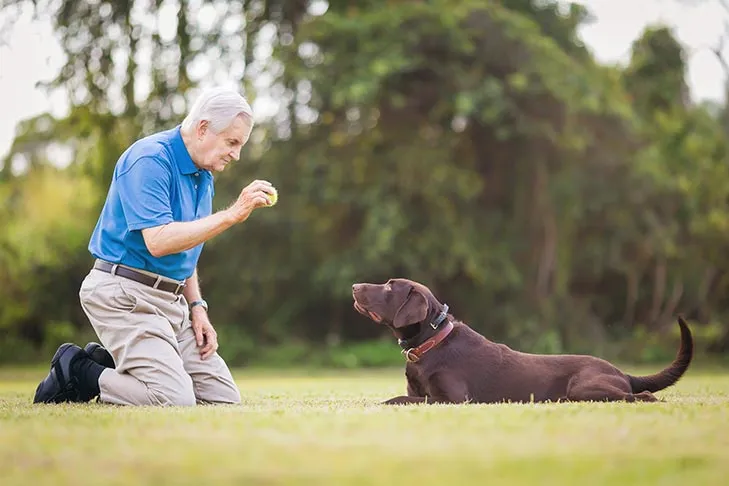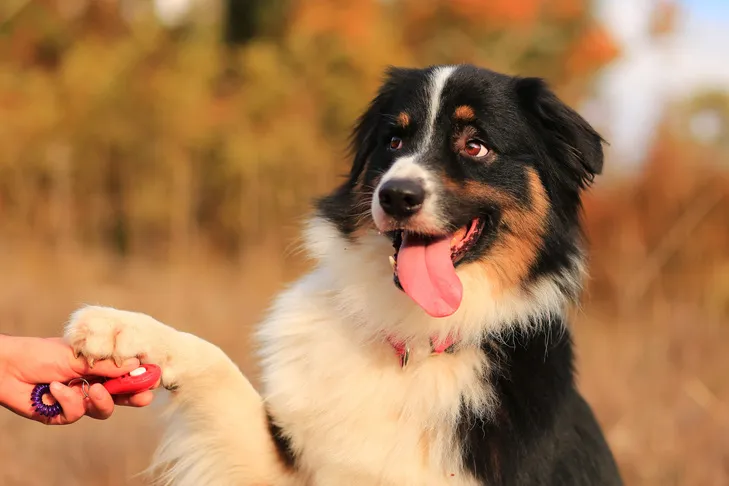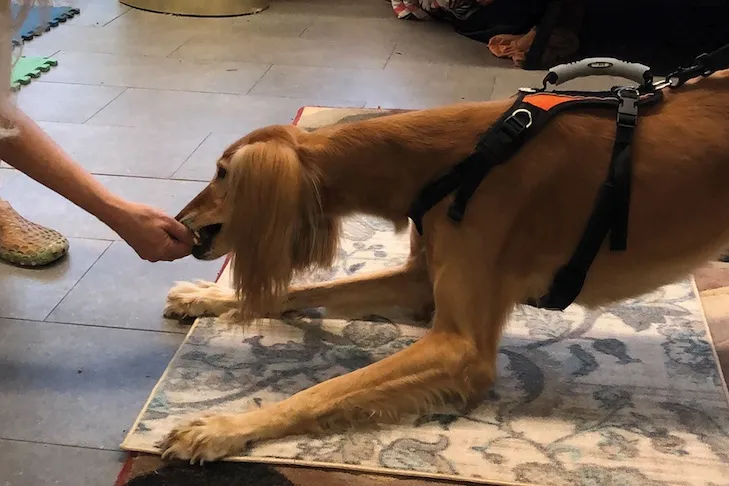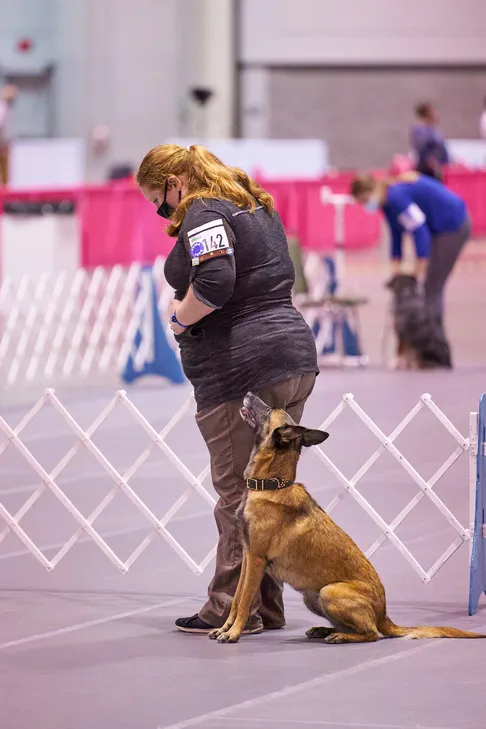Teaching your dog new tricks is more than just a delightful way to entertain; it’s a fantastic opportunity to strengthen your bond, stimulate their mind, and showcase their impressive capabilities. For dog owners often wondering “What Tricks Can I Teach My Dog” to keep their furry friends engaged, embarking on a trick training journey offers immense rewards. Beyond the joy of seeing your canine companion perform, mastering advanced tricks can even lead to earning official titles like those offered by the AKC Trick Dog program. If you’re looking to expand your dog’s repertoire of skills, explore some of the many impressive tricks I can teach my dog that will challenge and delight both of you.
To successfully teach these engaging dog tricks, patience is key, alongside a dedicated amount of time for consistent practice. You’ll primarily need positive reinforcement tools such as high-value dog treats, and if your dog is particularly toy-motivated, their favorite toys will also be invaluable. Many trainers find a clicker to be an excellent tool for marking the exact moment your dog performs the desired behavior, making the learning process clearer and more efficient for your pet. Always choose a quiet, distraction-free environment to work with your dog, allowing them to focus entirely on you and the task at hand.
How to Teach Your Dog to Catch a Treat or Toy
Teaching your dog to catch is a classic and highly rewarding trick that many canines naturally enjoy. To begin this fun exercise, have your dog positioned directly in front of you, ensuring you have their full attention with a tasty treat. Initiate the process by gently tossing a treat with an underhanded motion, aiming for their mouth. If your dog successfully catches the treat, shower them with enthusiastic praise to reinforce the positive behavior. Should they miss the treat, try to swiftly retrieve it before they can eat it off the ground, then reset and attempt the toss again.
 A Labrador Retriever eagerly anticipates catching a tennis ball thrown by an older gentleman.
A Labrador Retriever eagerly anticipates catching a tennis ball thrown by an older gentleman.
Repeat this catching drill several times during each training session. Consistency is crucial for your dog to grasp the concept. Once your dog is reliably catching tossed treats, you can gradually introduce lightweight toys they enjoy. When they successfully catch a toy, respond with plenty of praise, immediately followed by a treat reward. This transition helps generalize the catching skill from food to other objects. Remember, even if it feels hard to teach an old dog new tricks, patience and positive reinforcement are powerful tools for all ages and skill levels.
Mastering “Under the Bridge”
The “Under the Bridge” trick involves your dog crawling beneath your legs while you sit on the floor with your knees raised in a triangular shape. This trick not only looks impressive but also builds your dog’s confidence and body awareness. Start by having irresistible treats or a favorite toy ready to motivate your dog. Get down on the floor with your dog, elevating your knees to create the “bridge.” Position your dog on one side of your body, holding the treat or toy in your hand on the opposite side.
Reach the lure (treat or toy) under your legs, allowing your dog to sniff it, which naturally piques their interest. Slowly lower the treat or toy towards the ground, moving it steadily through the space under your legs. As your dog follows the lure, their body will naturally lower, and they will crawl through your legs. The moment your dog emerges on the other side, provide immediate praise and reward them with the toy or treat.
After several successful repetitions, you can begin to introduce a verbal cue of your choice, such as “under” or “bridge,” just as your dog starts to move beneath your legs. Once your dog is consistently performing the trick with the verbal cue, you can gradually phase out the lure. Eventually, you’ll be able to simply give the verbal cue, and your dog will respond by crawling under your legs, earning them praise and a reward.
Teaching Your Dog to “Speak” on Command
Teaching your dog to “speak” is a trick that can be both entertaining and useful, especially if you want to channel their natural barking tendencies into a controlled behavior. The most straightforward method for teaching this trick is through “capturing,” a training approach where you identify and reward a naturally occurring behavior, then gradually introduce a cue.
To start teaching “speak,” ensure you have treats readily available. Whenever your dog naturally barks, perhaps out of excitement or in response to an external stimulus, immediately mark that behavior with your chosen verbal cue (such as “talk” or “speak”) and promptly give your dog a treat. The use of a clicker can be particularly effective here, as it allows you to precisely mark the exact moment your dog barks, helping them clearly understand which action is being rewarded.
 A Dachshund howling and barking loudly in a yard.
A Dachshund howling and barking loudly in a yard.
With consistent repetitions of marking and rewarding, your dog will begin to connect their barking with your verbal cue and the subsequent reward. It’s crucial, however, to manage this trick to prevent excessive barking. Once your dog understands the command, make sure to only reward them when they bark specifically in response to your cue, rather than unsolicited barking. This helps them learn that barking is only rewarded when you ask for it. This selective rewarding is also useful for addressing other barking issues, such as when you need to stop a dog from barking when someone comes to the door unexpectedly.
The Art of Leg Weaves
Leg weaves are an impressive and fluid trick that demonstrates excellent coordination between you and your dog. Begin practicing in a safe, open area without a leash, which could otherwise get tangled around your legs. Stand with your legs wide apart, and have your dog positioned in front of you. Hold a treat in one hand behind your legs; this position allows you to lure your dog through and around your legs more effectively than trying to push from the front. Bend your knees slightly and use the treat to guide your dog to walk between your legs. As your dog passes through, offer praise and a treat.
Once your dog is comfortable with this initial movement, use another treat to guide them through your legs and then around one of your legs, bringing them back to the starting position in front of you. Allow your dog to lick or nibble the treat as you guide them, which helps maintain their focus and position. When they return to the front, offer more praise and another treat.
After your dog confidently follows the treat through your legs and around one side, repeat these steps to teach them to go through and around your other leg. When your dog consistently follows your lure through your legs and around both sides, it’s time to connect these movements into a continuous figure-8 pattern. Start by luring your dog through your legs and around your right leg, then immediately guide them around your left leg before rewarding.
Next, you can begin to fade out the treat lure. Start using an empty hand to guide your dog through the weave pattern. When your dog successfully follows your empty hand, introduce a verbal cue like “weave” or “legs.” With further practice, you can gradually phase out the empty-handed lure entirely, as your dog will begin to recognize your bending-knee body language as the physical cue for the trick. Once your dog has mastered leg weaving while you are stationary, you can advance to teaching them to weave while you walk forward. Begin by taking large, slow steps as you cue your dog to weave. Reintroduce the treat lure temporarily to help build their confidence with the added movement. As your dog gains experience, you can phase out the lure again and gradually increase your walking speed and shorten your steps to refine this impressive trick.
How to Teach Your Dog to Shake Hands
Teaching your dog to shake hands is a classic gesture of greeting and a popular trick that showcases their ability to interact politely. To begin, simply hold your hand out towards your dog. Initially, your dog might lick or sniff your hand; ignore these behaviors. The moment your dog paws at your hand, immediately mark this action with praise or a click, and then reward them with a treat. Repeat this process until your dog consistently paws at your outstretched hand.
 An Australian Shepherd carefully learning to offer its paw outdoors.
An Australian Shepherd carefully learning to offer its paw outdoors.
Once your dog reliably paws your hand, the next step is to build the duration of their paw resting on your hand. To do this, wait for their paw to settle on your hand for a second or two before clicking or praising and then rewarding. Begin with very short durations, perhaps just one or two seconds, and gradually increase the time as your dog understands what is expected.
When your dog is consistently placing their paw on your hand and holding it until rewarded, introduce a verbal cue like “shake” or “hello.” At this point, you can also modify your hand position by flattening it and holding it vertically with a treat, mimicking a human handshake. Begin to incorporate a gentle up-and-down motion with your hand before giving the treat. This refines the movement into a true “shake.” This trick, along with others that involve polite greetings, can be a great way to manage behaviors like when you need to stop your dog from jumping on guests.
The Clever Trick of “Yes” and “No”
This advanced trick allows your dog to seemingly answer “yes” or “no” to your questions, a feat that is sure to amaze anyone who witnesses it. To teach your dog to “say yes,” hold a high-value treat concealed in a closed fist, or use another distinct hand signal of your choosing. Slowly move the hand holding the treat (or simply your hand as a lure) up and down, encouraging your dog to follow the movement with their nose, which will naturally result in a head nod. As soon as they nod, reward your dog with the treat.
Once your dog consistently follows your fist or hand up and down, try performing the motion without a treat visibly in your hand. When your dog still nods their head, offer praise and then provide a treat with your other hand. With ongoing practice, the closed fist or specific hand signal will become the established physical cue for your dog to nod their head, and you can gradually discontinue the up-and-down hand movement.
To teach your dog to “say no,” you’ll employ a similar capturing and luring approach but with a distinct hand signal and motion. Instead of a closed fist, use a different signal, such as a closed fist with your pointer finger extended upwards. To elicit a head shake, move your hand slowly from side to side. As your dog follows this side-to-side motion with their head, it will create the appearance of them shaking their head “no.” When your dog moves their head to follow your hand, praise them and deliver a treat. Through consistent practice, the extended pointer finger will become the specific physical cue for your dog to shake their head in response.
Teaching Your Dog to Bow
The “bow” is an elegant trick that involves your dog lowering their front end while keeping their rear end up, resembling a play bow. It’s not only visually appealing but also a good stretch and strength-building exercise for your dog. Start with your dog standing directly in front of you. Capture their attention with a treat held in your hand. Then, use the treat to lure their nose down between their front legs and back towards their chest and belly. As your dog follows this treat lure, they will naturally move into the distinctive bow position. Praise and treat your dog immediately. Afterward, toss another treat away from them to encourage them to move out of the bow, preventing them from automatically going into a full “down” position. Repeat this process over several dedicated practice sessions.
While luring the nose between the front legs works well for many dogs, some may instead collapse directly into a “down” rather than a bow. If this happens, experts like Penny Leigh, CPDT-KA, Director of the AKC GoodDog Helpline (GDH), suggest a modified approach. Try lightly placing a hand or even just a finger on your dog’s stomach, just below the loin. This subtle pressure can help cue them that you are not asking for a “down” and encourage the correct bow posture.
 A black and white dog elegantly performing a bow, demonstrating flexibility and strength.
A black and white dog elegantly performing a bow, demonstrating flexibility and strength.
Once your dog consistently follows the food lure into the bow position, begin to use an empty hand as the lure. Continue to treat your dog after they successfully enter the bow position. When your dog is reliably following the empty-hand lure, you can introduce a verbal cue of your choice, such as “bow” or “fancy.” With consistent practice, your dog will develop the necessary strength and coordination to hold the bow position for longer periods. You can also gradually phase out your physical hand lure and, over time, evolve the physical cue for this trick to you performing a small bow or curtsy yourself, adding a charming personal touch to the command.
How to Teach Your Dog to Make a Circle (Spin/Twirl)
Teaching your dog to spin or twirl in a circle is a dynamic and fun trick that many dogs pick up quickly. Begin by getting your dog’s attention with a high-value treat or their favorite toy. Hold the lure just above your dog’s nose. Slowly move your hand in a large circular motion, guiding your dog’s nose as they follow the treat or toy, causing them to walk in a circle. As soon as your dog completes the circle, offer enthusiastic praise and a treat. After a few repetitions, once your dog is consistently following the lure in a circular motion, you can introduce your chosen verbal cue (such as “spin,” “twirl,” or “around”).
Next, use the exact same technique to lure your dog into a spinning motion in the opposite direction. When your dog is consistently following your lure to spin the other way, add in a distinct verbal cue for that direction, or use the same cue with a directional hand signal. Once your dog reliably follows your verbal cue to spin in both directions, you can transition to using the circular hand motion without a treat in your hand, combined with your verbal cue. When your dog spins in response, provide praise and a treat. This trick helps develop your dog’s balance and responsiveness.
Playing “Peekaboo” with Your Dog
The “Peekaboo” trick, often also called “middle,” involves your dog coming and settling between your legs, which can be a very practical skill for navigating tight spaces or simply keeping your dog close and focused on you. To teach your dog Peekaboo, start by standing in front of your dog, both of you facing the same direction. Hold a treat in your hand to capture their attention. When your dog moves forward and passes through your legs, immediately offer praise and a treat.
 A person standing with their dog positioned between their legs, demonstrating the “Peekaboo” or “Middle” trick.
A person standing with their dog positioned between their legs, demonstrating the “Peekaboo” or “Middle” trick.
After a few successful repetitions, you can introduce a verbal cue of your choice, such as “middle” or “peekaboo,” spoken as your dog begins to come between your legs. Once your dog is settled comfortably between your legs, you can use a release cue (if you have one) or simply toss a treat away to encourage them to move out of position, preparing for the next practice round. As you continue to practice, you’ll gradually be able to fade out the need to lure your dog forward with a visible treat. Eventually, your dog will respond directly to the verbal cue to move into the “Peekaboo” position, making for a neat and useful command.
Conclusion
Teaching your dog a variety of tricks, from the classic “catch” to the more intricate “leg weaves” or “yes and no” responses, is an incredibly enriching experience for both of you. It’s a journey that goes beyond simple obedience, fostering a deeper understanding, enhancing mental stimulation, and building a stronger, more joyful bond. Each new skill mastered boosts your dog’s confidence and responsiveness, transforming daily interactions into engaging learning opportunities.
Whether you’re aiming for AKC Trick Dog titles or simply want to impress friends and family, the investment of patience and positive reinforcement will yield remarkable results. So, grab your treats, find a quiet spot, and start exploring the exciting world of dog tricks. Not only will your dog learn impressive feats, but you’ll also discover the immense satisfaction of working together and celebrating every success along the way. If you find yourself facing specific challenges in your dog’s behavior, like when your my dog will not stop pulling on the lead, remember that consistent training and professional guidance can help.
